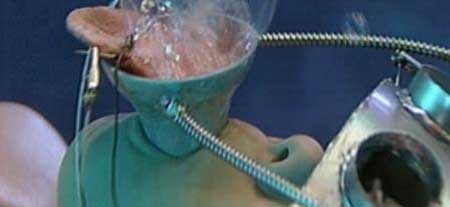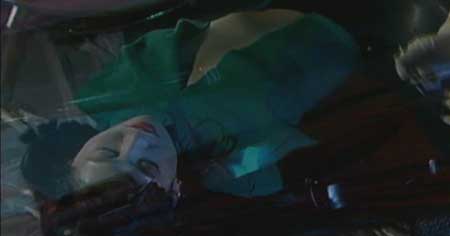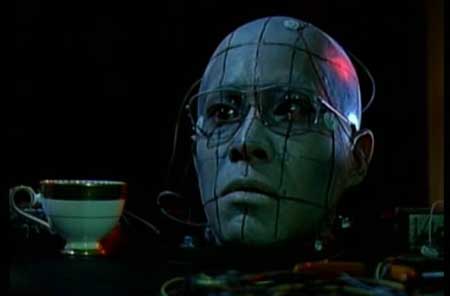
SYNOPSIS:
By the time of Android of Notre Dame, the fifth installment in the Guinea Pig Series, any mondo factualization of the fictional has disappeared. Instead, we have a typical cyberpunk narrative as if focalized through the fevered imagination of Manfred Clynes who posited in the 1960s that the body would become redundant at the interface of new cybernetic technologies. One day, Karazawa, a scientist who is desperately searching for a cure for a terminal illness which threatens to rob him of his sister, gets a phone call from a stranger, Kato, who seems to offer him a solution by offering to procure a human subject for Karazawa’s research for monetary compensation. Desperate Karazawa takes him up on his offer, however while he eventually discovers the secret of life, it does not bring him the happiness that he desires.
REVIEW:
To be honest, Android of Notre Dame, is one of my least favourite films in the Guinea Pig series. It doesn’t have the unrestrained brutality of the earlier films, the deranged pathos of Mermaid in a Manhole/ Za Ginī Piggu: Manhōru no naka no Ningyo (Hideshi Hino: 1988) or the exuberance and excess of the next film, Devil Woman Doctor (Ginī Piggu 4: Pītā no Akuma no Joi-san?, Hajime Tabe: 1986) which was actually made before Android [and after He Never Dies] but released after it). Instead we have a Japanese variation on the Frankenstein myth, that has been done better elsewhere – for example Tetsuo: The Iron Man (Shinya Tsukamoto: 1989) in which Tomorowo Taguchi who plays Kato also appears – which seems slow even for its relatively short length – 50 odd minutes. Performances are perfunctory to say the least, and Toshihiko Hino fails to convince as the diminutive Frankensteinian scientist whose obsession with saving his sister leads him into a Promethean pact with the devil.


The best moment is when Kato visits Karazawa in order to attempt to squeeze more money out of him and instead finds himself as a living ‘guinea pig’ for Karazawa’s research. Having been reduced to a living head, Kato is brought face to face with his partner, and lover, who sadly reaches out to him l to caress his face only to be caught in the embrace of Kato’s computerised hands with the life being squeezed out of her in a final deadly embrace. As Kato’s head explores and white goo drips out of one of his disembodied eyes, the orgasmic death throes of the couple create an overt visual link between death and sex. Indeed, one of the most fun things to do when watching Android of Notre Dame is to look for example of ingenious ways to get around Japanese censorship regulations of the time without resorting to pixilation, which of course only function to fixate the attention on what is missing and/or what cannot be shown (of course, as some of you may well know, pubic hair was a no-no and women could be shown in any number of demeaning sexualized positions as long as a stray strand of pubic hair did not find its way into the frame). It should come as no surprise that the director, Kazuhito Kuramoto, made his mark in the Japanese film industry with ‘sex’ films, including Bondage Teacher/ SM: Rinko no omorashi (1986).

The philosophical undertones about loneliness and isolation which are a dominant feature of most of the Guinea Pig films are evident here, embodied within Karazawa’s desire not to let his sister die which is counterbalanced by her desire to die, and to be at ‘peace’ – in fact she berates him for bringing her back to life rendering all of Karazawa’s experiments meaningless, and his victory over death a hollow one. He is left an Android, alone, in a world of silence and nothingness, a prison that he has created himself through his desire to become a God and interfere with the natural order of things. There are some sad and meditative moments here, particularly in the opening and closing scenes of the film, in which Karazawa speaks directly to camera of his loneliness and despair. However while the philosophical framework is interesting, it does not make up for a film with little in the way of characterisation and whose ‘gore’ scenes do not live up to the high standard of previous films in the series.


Overall, Android of Notre Dame is weakest in the Guinea Pig series, and is worth seeing probably only if you are a completist and want to see the series in its entirety. As an exemplar of the series itself, the film falls flat and is not particularly innovative or inventive. There needed to be either more outright gore and/or black humour to make Android of Notre Dame a worthwhile entry into one of the most contentious but arguably interesting horror films series of the twentieth century. I would recommend tracking down Mermaid in a Manhole or Flower of Blood and Flesh instead.
Guinea Pig: Android of Notre Dame (1989) – CAT III
 Horror News | HNN Official Site | Horror Movies,Trailers, Reviews
Horror News | HNN Official Site | Horror Movies,Trailers, Reviews





